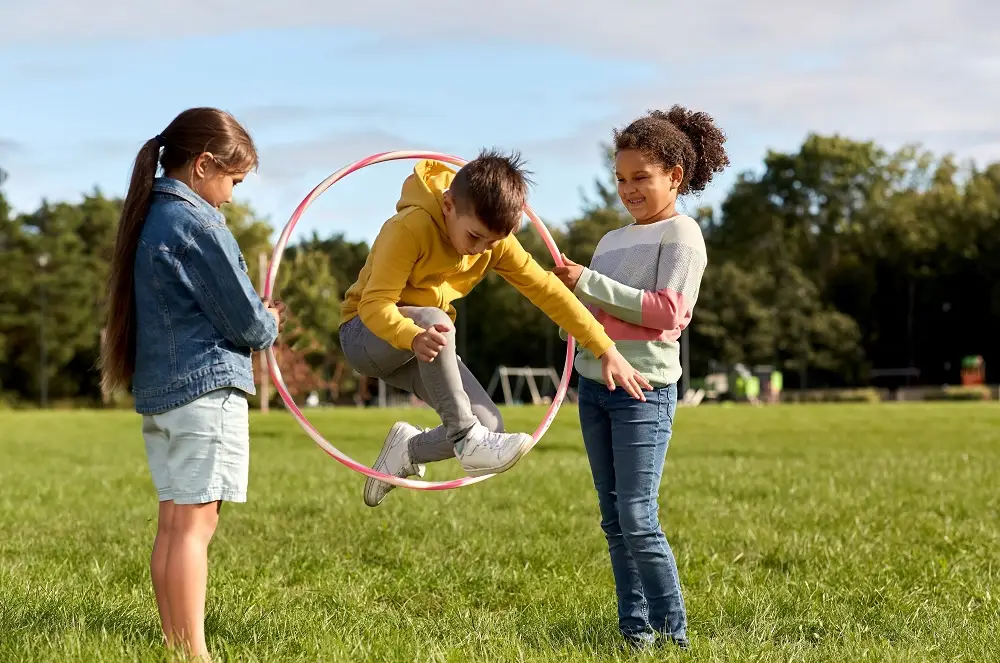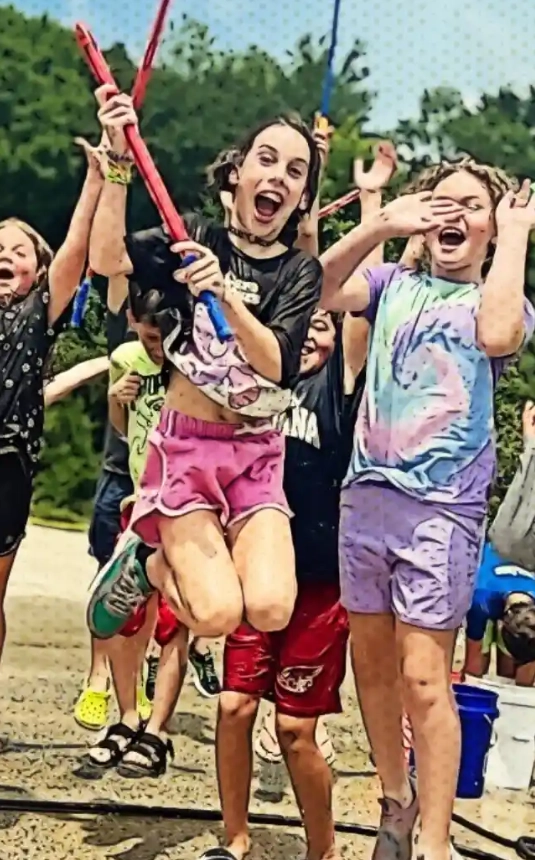Looking for a fun and engaging activity to keep your kids active and entertained? Why not create a DIY obstacle course right in your own backyard? Obstacle courses offer a wide range of benefits for children, including physical development, cognitive skills enhancement, and social skills improvement.
Creating a backyard adventure blends fun with meaningful development. Whether it’s a weekend play date, summer challenge, or creative backyard adventure, obstacle courses bring meaning to movement. So let’s dive in and discover the excitement that awaits in your very own backyard obstacle course!
Understanding the Benefits of Obstacle Courses for Kids
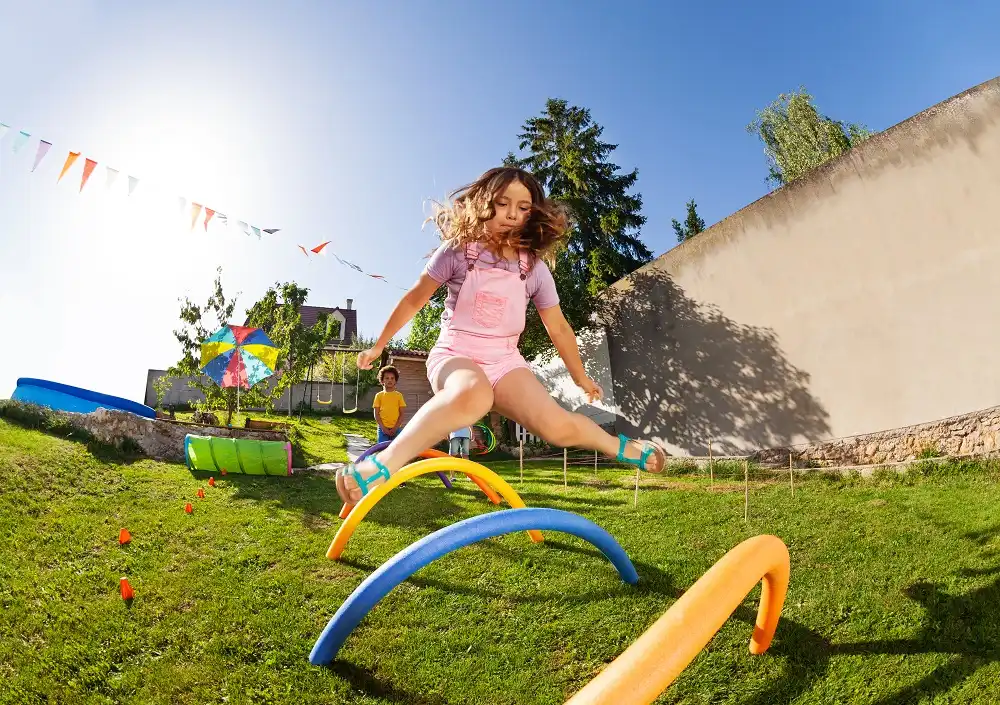
Obstacle courses are not just about having fun; they offer numerous benefits for children’s development. Let’s take a closer look at some of the advantages:
- Physical development: Obstacle courses provide an excellent opportunity for children to engage in physical activity and develop their gross motor skills. Kids strengthen their upper and lower body muscles while improving balance, coordination, and spatial awareness through multi-directional movements.
- Cognitive skills enhancement: Children are required to plan their route, strategize their movements, and problem-solve as they encounter different challenges. These mental activities enhance their decision-making, spatial awareness, and critical thinking abilities.
- Social skills improvement: When children encounter a challenging obstacle, they may need to work together to figure out the best way to overcome it. They learn to communicate their ideas, listen to others, consider their peers’ needs and abilities, and compromise to reach a common goal.
The combination of physical and mental challenges creates well-rounded growth opportunities that traditional activities may lack.
Essential Safety Tips for DIY Obstacle Courses
Before diving into the planning process, it’s crucial to prioritize safety when creating a DIY obstacle course. Here are some essential safety tips to keep in mind:
- Choose the right location: Remove any potential hazards such as sharp objects, rocks, or tree branches, and consider the terrain to avoid slippery or uneven surfaces. Avoid setting up the course near busy roads or bodies of water.
- Use safe materials: Avoid using materials that may cause injury, such as sharp edges or unstable structures. Opt for cushioned or padded materials where appropriate. Regularly inspect and check for signs of wear and tear, such as loose screws or frayed ropes.
- Supervise and control: Always ensure adult supervision, especially for younger children. Establish clear rules and safety guidelines, ensuring that everyone understands and follows them. Encourage children to take turns and wait for their chance to avoid collisions or injuries.
Consider the weather conditions when choosing the location. Rain or extreme heat can make the course more challenging and potentially dangerous. Plan the obstacle course on a day with favorable weather to ensure the safety and enjoyment of all participants.
Safety should always be your top priority, but that doesn’t mean it limits creativity. You can create exciting challenges that push boundaries while keeping everyone secure with proper precautions.
Planning Your Backyard Obstacle Course
Now that you understand the benefits and safety precautions, it’s time to plan your backyard obstacle course! Here’s a step-by-step guide to help you get started:
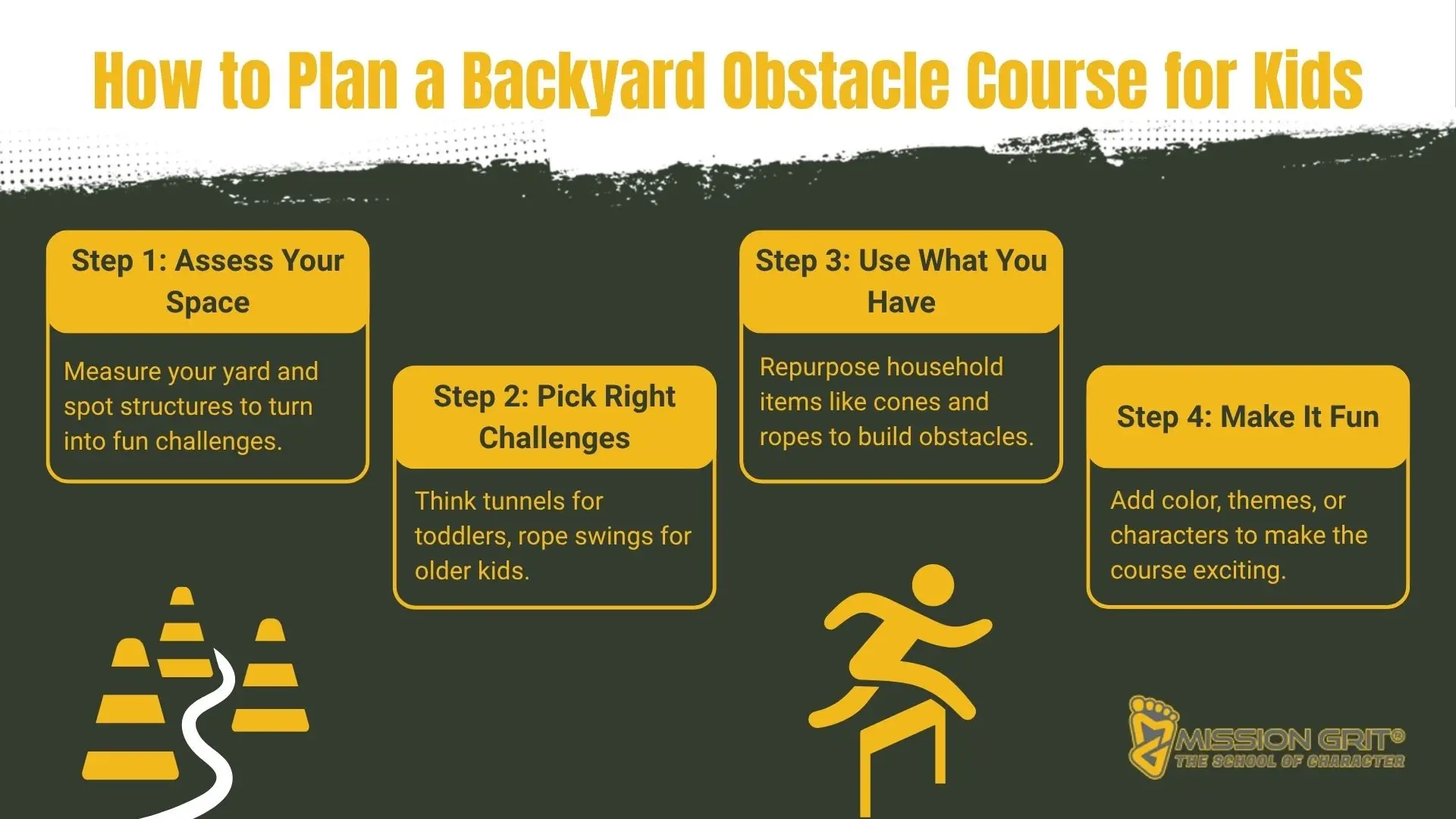
- Assess your space: Consider the dimensions, layout, and any existing structures that can be turned into obstacles. For example, if you have a tree with low-hanging branches, you can create a challenge where kids have to climb up and down the tree using the branches as handholds.
- Pick age-appropriate challenges: Select challenges that match your children’s age. For younger children, include activities like crawling under a low net, jumping over small hurdles, or balancing on a beam. Older kids can take on more complex obstacles such as a rope swing, monkey bars, or a mini rock climbing wall.
- Gather materials: Collect household items, outdoor equipment, and simple supplies based on your chosen obstacle course ideas. Many effective obstacles can be created using items you already have at home, so this is a budget-friendly activity.
- Incorporate fun elements: Use colorful flags or ribbons to mark the start and finish lines. Add themed decorations or incorporate popular characters to increase the appeal. The more engaging and enjoyable the course looks, the more excited your kids will be!
Planning ensures your obstacle course runs smoothly and safely. Take time to sketch your design and consider traffic flow to prevent bottlenecks or collisions.
17 Easy and Fun DIY Obstacle Course Ideas
Ready to get started? Here are some easy and fun DIY obstacle course ideas that you can incorporate into your backyard setup:
1. The Classic Tire Run (or Hula Hoop)
Things you’ll need: Old tires or hula-hoops.
Arrange a series of old tires on the ground, spacing them out to create a pathway. Kids can either jump inside the tires or step from one tire to another, testing their balance and coordination skills.
Imagine the excitement on your children’s faces as they navigate through the tire run, feeling the texture of the rubber beneath their feet. The sound of their footsteps echoing through the air adds to the thrill, creating a sensory experience that engages their senses.
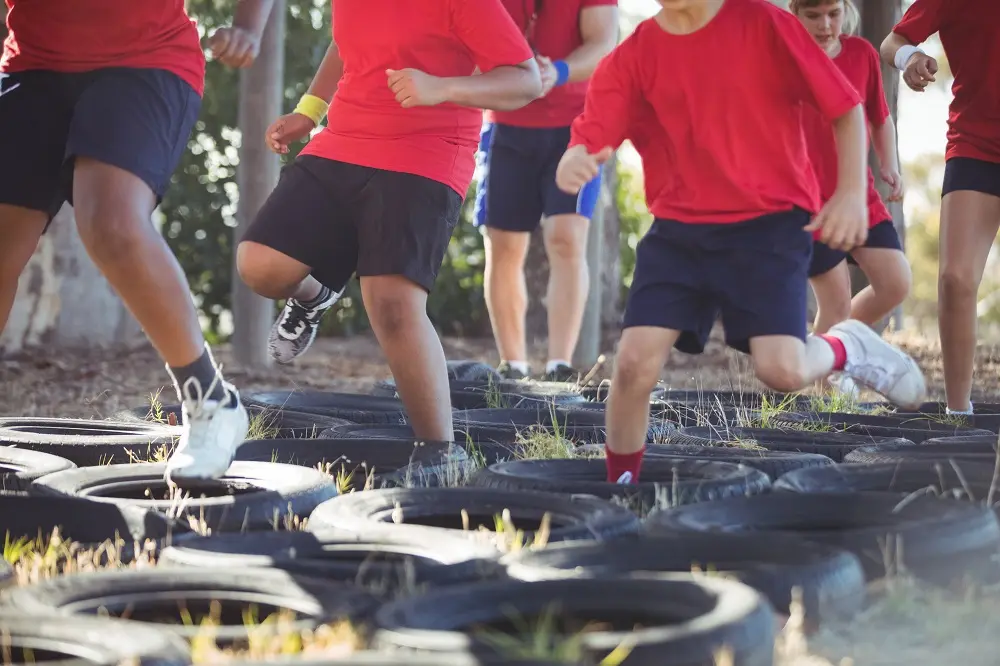
2. The Balancing Beam
Things you’ll need: Wooden beam or plank, cushions or mats for safety.
Place a narrow and sturdy wooden beam or plank on the ground. Kids must walk across the beam, testing their balance and focus. For added safety, place cushions or mats around the beam in case of falls. As your children carefully place one foot in front of the other, they develop a sense of body awareness and control.
3. The Crawl Under
Things you’ll need: Rope, two sturdy posts or chairs, cardboard boxes, or pool noodles.
To make a tunnel for an obstacle course, simply tie a rope between two chairs at a low height and drape a blanket over it. You can also make a tunnel by lining up boxes or bending noodles into arches. Kids must crawl underneath, improving their agility and body control. Ensure that the tunnel is wide enough for safe passage. They learn to adapt to different spaces, enhancing their spatial awareness and problem-solving skills.
4. The Jump Over
Things you’ll need: Pool noodles, cones, or small hurdles.
Set up small hurdles or cones at intervals along the course. Kids must jump over these obstacles, enhancing their leg strength and explosive power. Adjust the height of the hurdles according to the children’s age and abilities. With a burst of power, children leap into the air, defying gravity and challenging their physical limits.
5. Over-Under Hurdles
Things you’ll need: PVC pipes or wooden beams, adjustable supports.
Set up a series of hurdles using PVC pipes or wooden beams at varying heights. Participants have to either jump over or crawl under each hurdle as they make their way through the course. This creates a dynamic flow that keeps kids engaged and thinking about their next move.
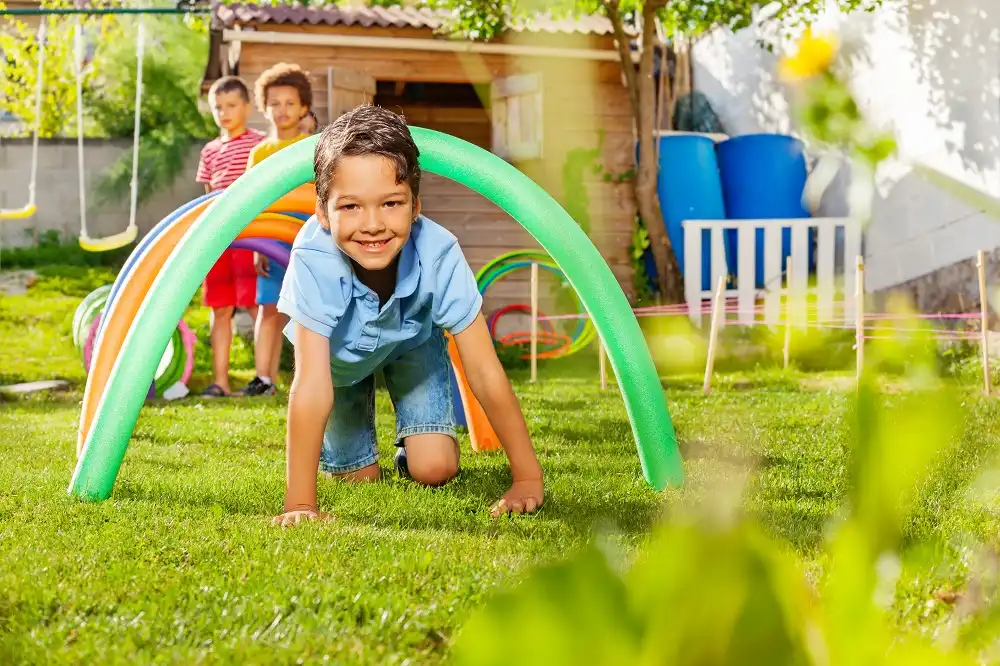
6. Agility Ladder
Things you’ll need: Rope or masking tape, measuring tape.
Lay out a ladder-shaped structure on the ground using ropes or tape. Participants have to step or jump into each ladder square as quickly as possible without touching the lines. This exercise improves foot speed and coordination while building rhythm and timing.
7. Wall Climbing
Things you’ll need: Wooden panels or a sturdy outdoor structure, safety mats.
Build a wall using wooden panels or repurpose a sturdy outdoor structure. Participants must find a way to climb up and over the wall to continue the course. This challenge builds strength and coordination while fostering a child’s leadership as they face fears, problem-solve, and take initiative in guiding themselves or others through the task.
8. Tire Flip
Things you’ll need: Large tractor or car tires.
Place large tractor or car tires on one side of the course. Participants have to flip the tires over to the other side using their strength and technique. This full-body exercise builds power and teaches proper lifting mechanics.
9. Monkey Bars
Things you’ll need: Horizontal ladder or monkey bar set, safety mats.
Install a set of monkey bars or a horizontal ladder between two sturdy posts or trees. Participants need to swing across the bars without falling off. This classic playground equipment builds grip strength and upper body endurance.
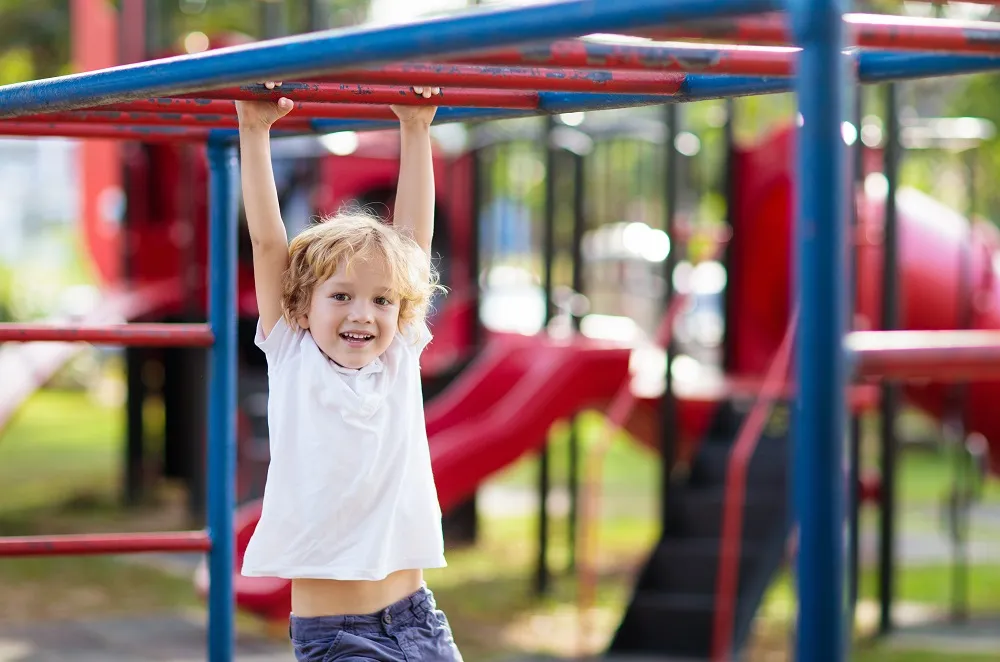
10. Water Obstacle
Things you’ll need: Kiddie pools, floating platforms, inflatable obstacles.
If you have access to a pool, pond, or a safe water area, you can incorporate water-based challenges such as swimming through hoops, crossing floating platforms, or navigating an inflatable obstacle course. Water obstacles add refreshing fun during hot summer days. As safety is always the priority, ensure there’s always an adult around any water features.
11. “Hot Lava” Course
Things you’ll need: Various platforms (cardboard boxes, stepping stones, pillows), red fabric or paper.
Create a “hot lava” course by placing obstacles like cardboard boxes, stepping stones, and pillows across your floor or yard. Cover the ground with red fabric or paper to represent lava. Children must navigate from one platform to another without touching the “lava”, developing balance and strategic thinking while engaging their imagination.
12. Laundry Basket Throw
Things you’ll need: Laundry baskets, bean bags or soft balls, masking tape.
Set up laundry baskets at various distances and heights throughout your course. Provide bean bags or soft balls for children to throw into the baskets as they pass by. It’s an obstacle course combining movement with hand-eye coordination. Plus, there’s a skill-based challenge to the physical course.
13. Pool Noodle Tunnels & Hurdles
Things you’ll need: Pool noodles, duct tape, ground stakes or weights.
Pool noodles aren’t just for water. Create versatile obstacles using pool noodles bent into arches for tunnels or set at various heights for hurdles. Secure them to the ground with stakes or weights, creating a colorful pathway that children can crawl under or hop over. The soft material makes this a safe option for younger children.
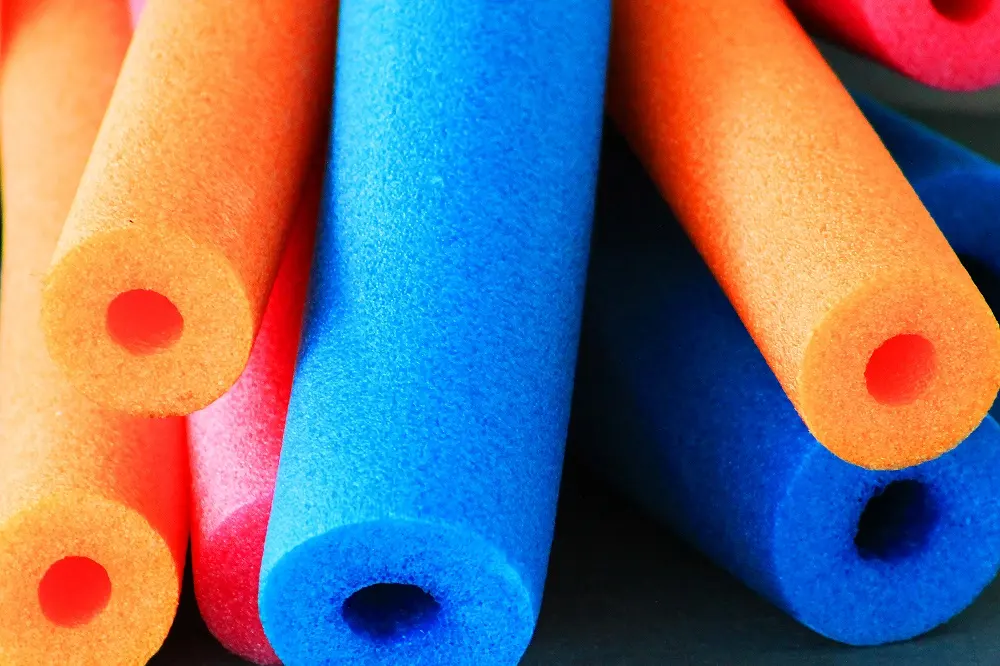
14. Color or Shape Matching Obstacles
Things you’ll need: Colored paper or shapes, matching cards, tape.
Place colored shapes or papers throughout your obstacle course and give children matching cards. They must collect or touch the matching colors or shapes in a specific order as they navigate the course. This adds cognitive challenge to physical activity and works well for educational play.
15. Animal Movement Stations
Things you’ll need: Rope, hoops, floor space, animal signs.
This is the perfect obstacle course for animal lovers. Create stations where children must move like different animals; bear crawl under a rope, hop like a bunny through hoops, or slither like a snake across the floor. Post signs at each station showing the animal and the movement required. This imaginative approach makes exercise feel like play while building different muscle groups.
16. Obstacle Dice Roll Game
Things you’ll need: Large foam die, obstacle markers, open space.
Roll a large foam die to determine the next movement challenge (jump, crawl, hop, spin, march, or skip). Create corresponding obstacle stations and let the dice determine which challenge comes next. This element of chance keeps kids engaged and adds unpredictability to the course.
17. Relay Races
Things you’ll need: Various obstacle materials, team markers, timer.
Set up multiple obstacle stations and divide children into teams for relay competitions. Each team member completes a different obstacle before tagging the next person. This creates an excellent team-building activity that revolves around cooperation, friendly competition, and exercise.
Bonus: Indoor Obstacle Course Ideas
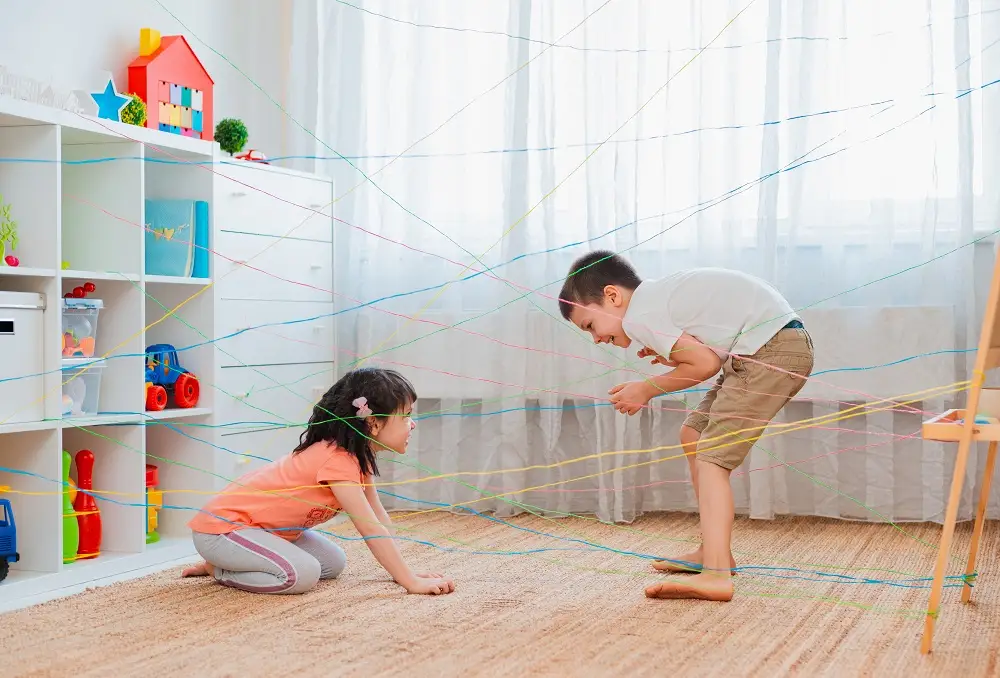
Don’t let weather stop the fun! Many of these obstacle course ideas can be adapted for indoor use, transforming your living room into an adventure zone. Indoor options work perfectly when creating courses on a smaller scale:
- Pillow stepping stones: Place pillows in a straight line or zig-zag pattern across the floor for children to hop between without touching the ground.
- Two chairs tunnel: Use two chairs with a blanket draped between them to create a crawl-through tunnel.
- Masking tape balance beam: Create a balance beam using masking tape on the floor – it’s safe and won’t damage surfaces.
- Bean bag toss stations: Set up containers around the room for children to toss bean bags filled with dried beans into while navigating.
- Cardboard box maze: Connect cardboard boxes to create tunnels and hiding spots for a more complex indoor adventure.
- Furniture obstacle course: Use existing furniture as obstacles — crawl under tables, weave between chairs, or hop over cushions.
Indoor obstacle courses provide the same developmental benefits as outdoor versions while offering climate-controlled comfort. They’re perfect for rainy days, extreme temperatures, or when you need to keep the activity contained to a smaller space.
Build Confidence, One Obstacle at a Time
By incorporating these easy and fun DIY obstacle course ideas, you can create an exciting and stimulating outdoor experience for your kids. Get creative, think outside the box, and personalize the course to suit your children’s interests and preferences. So what are you waiting for? Start building your backyard obstacle course today and watch your kids race towards excitement, development, and countless hours of fun!
At Mission Grit, we specialize in creating professional obstacle course experiences that combine physical challenges with character development. Our expert-designed courses are unique; they provide safe, structured environments where children can build confidence, develop fitness, and learn valuable life skills. We strive to help all kids feel more confident in their physical and mental capabilities. Contact us today to learn more about our programs and discover how professional obstacle training can benefit your child’s development.

